- Details
- Hits: 13868
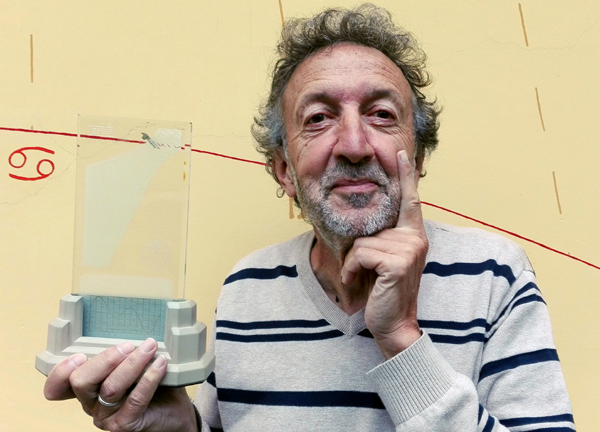 This year's Sawyer Dialing prize was awarded to Gianpiero Casalegno at the NASS annual conference in Pittsburgh, PA. The certificate recognizes Gian for "his achievements in harnessing modern digital technology to the benefit of traditional dialists around the world - 18 Aug 2018."
This year's Sawyer Dialing prize was awarded to Gianpiero Casalegno at the NASS annual conference in Pittsburgh, PA. The certificate recognizes Gian for "his achievements in harnessing modern digital technology to the benefit of traditional dialists around the world - 18 Aug 2018."
Gian was not able to attend the conference to receive the Sawyer Award, so Fred Sawyer read the certificate to NASS attendees and forwarded the award certificate and a custom made Spectra Sundial by Jim Tallman of Artisan Industrials to Gian in Italy. Gian chose to use the traditional cash prize of $200 to support the Bellingham Mural Sundial.
Gian prepared an acceptance speech that was read by Sawyer. Gian's began his talk with "My main contribution to gnomonics has been the development of several software programs [including Orologi Solari available to all at http://www.sundials.eu/download/download_enu.html] to help other people dealing with sundial design, simulation and restoration. Therefore today I would like to present a survey of my programs highlighting some unique aspects that could have been neglected or underestimated by most people."
- Details
- Hits: 10649
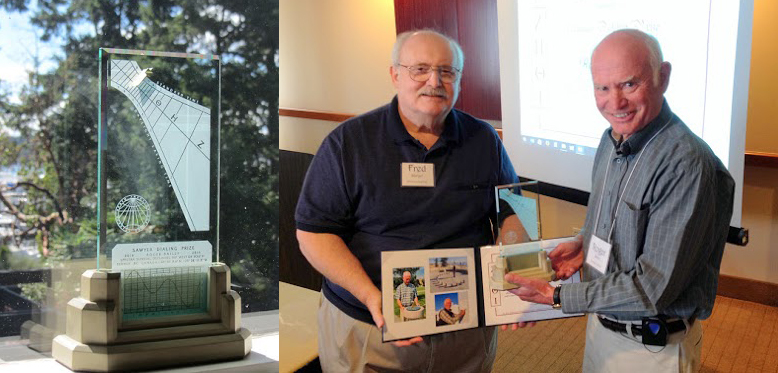
This year's Sawyer Dialing prize was awarded to Roger Bailey at the NASS annual conference in Portland, ME. The certificate recognizes Roger for "consistently showing the dialing community that all you need to know in life can be learned from studying sundials, and for using that study to advance the theory and practice of dialing."
Fred Sawyer presented Roger with an award certificate, the traditional cash prize of $200 and a custom made Spectra Sundial by Jim Tallman of Artisan Industrials.
On receiving the award Roger's presentation was "That is a Good Question". Here he pointed out that most of his achievements in the art and science of dialing was sparked by answering good questions, questions like the shadow lengths or the time and direction of sunrise sunset on analemmatic sundials or time systems on Islamic sundials. The theme was "Ask and you shall receive". He remains open to good questions.
- Details
- Hits: 13262
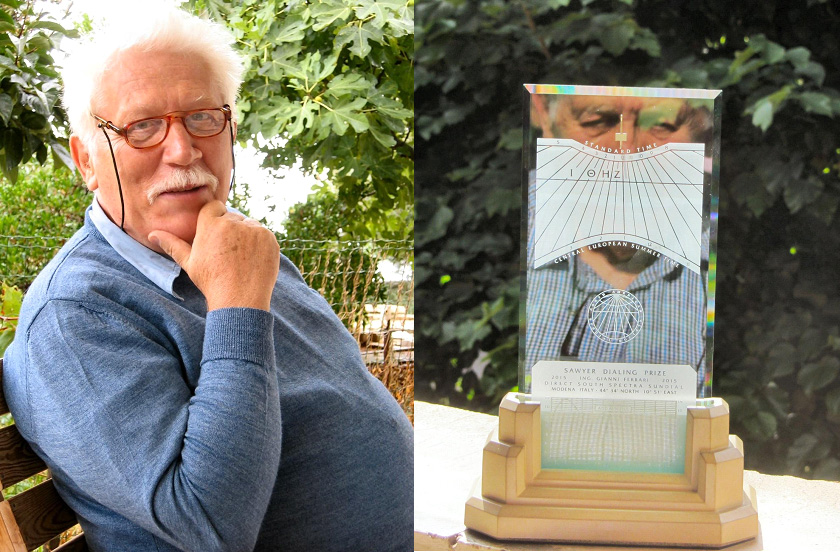 Ing. Gianni Ferrari was awarded the 2015 Sawyer Dialing prize, with his certificate acknowledging: "for his long career educating the dialing community about the nearly forgotten heritage of ancient Islamic gnomonics and the wide variety of modern analytically developed sundials." Since 2000 Gianni has contributed nearly 30 articles to the NASS Compendium, enriching dialists' knowledge around the world. Recently he published the books Le Meridiane Dell'Antico Islam (Sundials of Ancient Islam) and Formule e metodi per lo studio degli orologi solari piani - Caratteristiche, descrizione e calcolo degli orologi solar paini comuni e pop conosciuti (Formulae and methods for the study of flat sundials - with characteristics, descriptions and calculations of common and less known sundials). Gianni's acceptance presentation for the conference was on "Forgotten Dialing Formulas" using versines. The versine trigonometric function was engraved on ancient quadrants, forming the small arcs "versus" and "rectus" that were used for solving the Astronomical Triangle to derive solar azimuth and hour angle time. Those that have learned to navigate with a sextant may indeed remember using half versines or "haversines" tables. His presentation is in the September 2015 issue of the NASS The Compendium. Gianni was not able to attend the NASS Conference in Victoria, but sent greetings from Italy. He asked that NASS donate the $200 prize money to benefit an appropriate dialing cause. Like other dialing prize recipients, he received a Spectra Sundial by Jim Tallman of Artisan Industrials. Gianni's dial was designed for his home in Modena, Italy at 44o 34' N 10o 51' E.
Ing. Gianni Ferrari was awarded the 2015 Sawyer Dialing prize, with his certificate acknowledging: "for his long career educating the dialing community about the nearly forgotten heritage of ancient Islamic gnomonics and the wide variety of modern analytically developed sundials." Since 2000 Gianni has contributed nearly 30 articles to the NASS Compendium, enriching dialists' knowledge around the world. Recently he published the books Le Meridiane Dell'Antico Islam (Sundials of Ancient Islam) and Formule e metodi per lo studio degli orologi solari piani - Caratteristiche, descrizione e calcolo degli orologi solar paini comuni e pop conosciuti (Formulae and methods for the study of flat sundials - with characteristics, descriptions and calculations of common and less known sundials). Gianni's acceptance presentation for the conference was on "Forgotten Dialing Formulas" using versines. The versine trigonometric function was engraved on ancient quadrants, forming the small arcs "versus" and "rectus" that were used for solving the Astronomical Triangle to derive solar azimuth and hour angle time. Those that have learned to navigate with a sextant may indeed remember using half versines or "haversines" tables. His presentation is in the September 2015 issue of the NASS The Compendium. Gianni was not able to attend the NASS Conference in Victoria, but sent greetings from Italy. He asked that NASS donate the $200 prize money to benefit an appropriate dialing cause. Like other dialing prize recipients, he received a Spectra Sundial by Jim Tallman of Artisan Industrials. Gianni's dial was designed for his home in Modena, Italy at 44o 34' N 10o 51' E.
http://www.artisanindustrials.com/world-of-sundials/spectra-sundial-modena-italy.html
- Details
- Hits: 11785
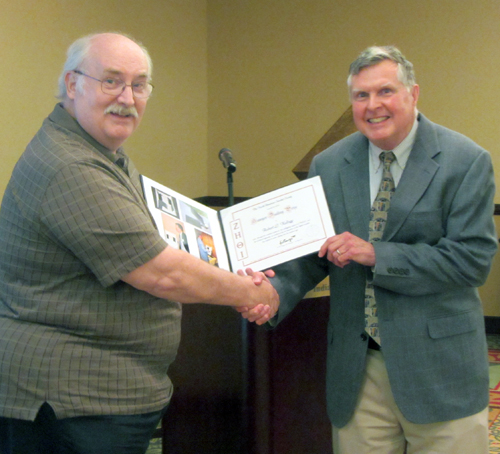 At the 2014 NASS Conference in Indianapolis, Indiana, Fred Sawyer announced this year’s Sawyer Dialing Award is given to Robert Kellogg, “who, through his constant outreach, his unflagging support of NASS, and his technical ingenuity, as evidenced by his invention of the digital sundial, has helped to usher dialing into the modern age.”
At the 2014 NASS Conference in Indianapolis, Indiana, Fred Sawyer announced this year’s Sawyer Dialing Award is given to Robert Kellogg, “who, through his constant outreach, his unflagging support of NASS, and his technical ingenuity, as evidenced by his invention of the digital sundial, has helped to usher dialing into the modern age.”
Bob designed and patented a digital sundial based on sunbeam projection, first considered when he was at the US Naval Postgraduate School. But it took more than a decade for those ideas to gel into a firm technical form and a US Patent.
Bob continues to write “Sundials for Starters”, a regular column for NASS's Compendium. Over the last several years he has organized the joint NASS-Analemma Society outreach at the US Science and Engineering Festival and has brought sundialing to Montgomery County Schools in Maryland for the last 20 years.
Fred Sawyer presented Bob with an award certificate, the traditional cash prize of $200 and a custom made Spectra Sundial by Jim Tallman of Artisan Industrials.
http://www.artisanindustrials.com/world-of-sundials/spectra-sundial-potomac.html
- Details
- Hits: 10745
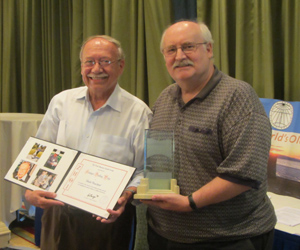 André Bouchard received the 2013 Sawyer Dialing prize at the Boston NASS Conference “In recognition of two decades of promoting, preserving, extending and exemplifying the pairimoine of Québecois of dialing and gnomonics.”
André Bouchard received the 2013 Sawyer Dialing prize at the Boston NASS Conference “In recognition of two decades of promoting, preserving, extending and exemplifying the pairimoine of Québecois of dialing and gnomonics.”
During the first 15 years of the CCSQ (la Commission des Cadrans solaires du Québec) André made numerous presentations on gnomonics, adopting objective and descriptive ways in order to highlight the specific elements of particular dials and dialist styles. Now as editor of The Gnomonist / Le Gnomoniste, André is rediscovering the fundamentals of philosophy through sundials, showing that they merge both in time, place, casting symbolic meaning and beauty within their surrounding. André illustrated this by discussing the design of the 2008 sundial on the shore of the St. Laurence River at Point aux Outardes Park near Baie-Comeau, where the polar gnomon and its supports simulate bull rushes, augmented by a flight of geese.
Fred Sawyer presented André with an award certificate, the traditional cash prize of $200 and a custom made Spectra Sundial by Jim Tallman of Artisan Industrials.
- Details
- Hits: 14589
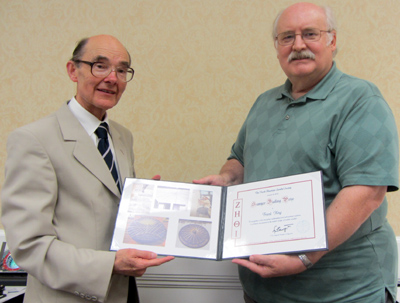 The 2012 Sawyer Dialing Prize was awarded to Frank King at the annual NASS Conference in Asheville, North Carolina.
The 2012 Sawyer Dialing Prize was awarded to Frank King at the annual NASS Conference in Asheville, North Carolina.
The award is given “In recognition of his innovative mathematical and astronomical solutions to problems encountered in the modern design of notable sundials.” Dr. King is Council Chairman of the British Sundial Society, Senior Lecturer of the Computer Laboratory at Cambridge University, and a Fellow of Churchill College where he is Chairman of the Churchill Archives Committee and Praelector. At Cambridge he also holds the responsibility of the University Bellringer, “one of the University’s most ancient and unusual posts” with the job of keeping the University Clock telling correct time.
He has designed many sundials including the vertical dial with Italian and Babylonian hours for Selwyn College, Cambridge (a new dial for Old Court), the Pembroke College vertical sundial, the noon mark wall analemma at 10 Paternoster Square in London, the unusual near-horizontal gnomon sundial as a memorial dial for Margaret Stanier, the analemmatic dial for Queen Elizabeth II Jubilee (2002) and the circular analemmatic dial for the MetroTransit Authority (Metropolitana) of Naples.
Frank was presented with a cash prize of $200 and a custom made Spectra Sundial by Jim Tallman of Artisan Industrials.
- Details
- Hits: 14661
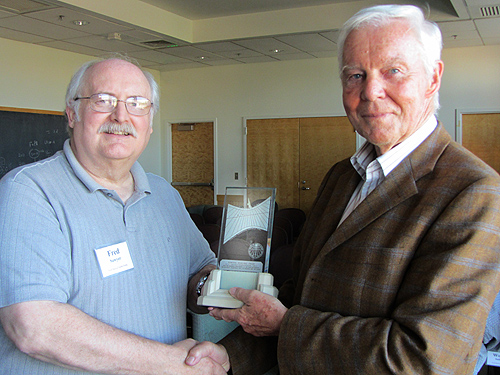 This year's Sawyer Dialing Prize awarded at the 2011 NASS Conference in Seattle Washington was given to Helmut Sonderegger, "In recognition of his ongoing development and support of the dialing software Sonne, and his many years of leadership in his national society." His acceptance talk was on one of the first Copernican followers, Rheticus.
This year's Sawyer Dialing Prize awarded at the 2011 NASS Conference in Seattle Washington was given to Helmut Sonderegger, "In recognition of his ongoing development and support of the dialing software Sonne, and his many years of leadership in his national society." His acceptance talk was on one of the first Copernican followers, Rheticus.
For many years Helmut Sonderegger has been active in the German Sundial Association and was chairman of a team of dialist to produce the 3rd Editiion of the Austrian Sundial Catalogue. His most famous free sundial software, „Sonne“ calculates about 20 different sundial types and his program „Alemma“ is devoted to the calculation of analemmatic sundials. The software is available at his website, www.helson.at. He endeavors to help people who make sundials through his software and through articles in the NASS Compendium and the German Rundschreiben, and for local groups.
Helmut was presented with a cash prize of $200 and a custom made Spectra Sundial by Jim Tallman of Artisan Industrials.
http://www.artisanindustrials.com/world-of-sundials/spectra-sundial-feldkirch-austria.html
- Details
- Hits: 25415
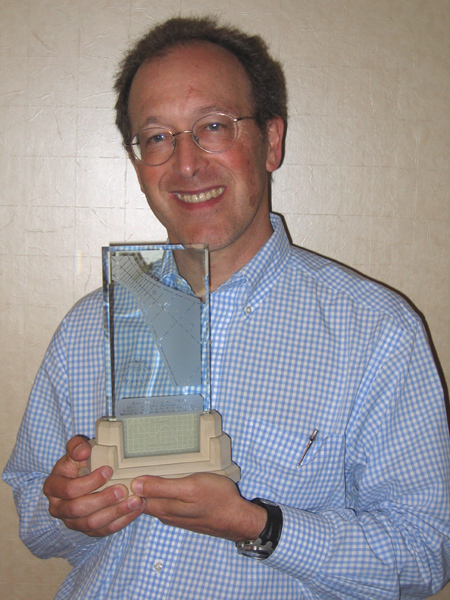 The 2010 Sawyer Dialing Prize goes to William L. Gottesman of Burlington, Vermont, "In recognition of his committment to innovation and high precision design in sundials which combine tradition with 21st century advances." Bill is designer of the Renaissance Sundial, a spiral sundial that uses curved mirrors to show the time to within 30 seconds. His dial is available at http://www.precisionsundials.com
The 2010 Sawyer Dialing Prize goes to William L. Gottesman of Burlington, Vermont, "In recognition of his committment to innovation and high precision design in sundials which combine tradition with 21st century advances." Bill is designer of the Renaissance Sundial, a spiral sundial that uses curved mirrors to show the time to within 30 seconds. His dial is available at http://www.precisionsundials.com
Bill collaborated with Kate Pond to design the Equatorial Band Sundial, dedicated during the 2010 NASS conference at Champlain College with the title "Come Light, Visit Me." On a smaller scale, but with no less precision, Bill worked with Fred Sawyer to realize the Sawyer Equant Sundial that will show both solar and clock time. To "advertise" the 2010 NASS conference, Bill even designed the back end of his car as a sundial, using the radio antenna as a gnomon.
As in past years, Bill was presented with $200 to fund a sundial project of his choice and a custom made Spectra Sundial by Jim Tallman of Artisan Industrials:
http://www.artisanindustrials.com/world-of-sundials/spectra-sundial-burlington-3.html
